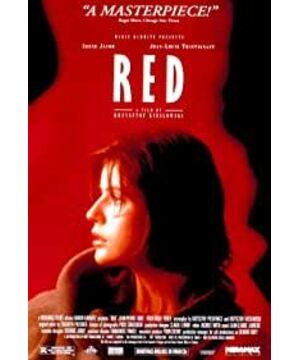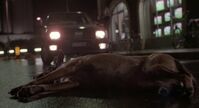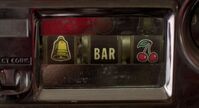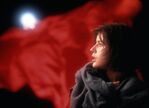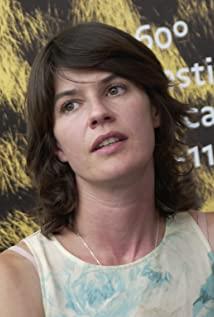"Three Colors: Red" is the third part of the "Color Trilogy" by the famous Polish film director Krzysztof Kislowski. The main color red in the film is almost everywhere: red jeeps, red cars, red jackets, red bars in the ballet training hall, red traffic lights, red seats in the bowling alley, red ribbons, red in the judge's house The walls, the lifeguard's red outfits...especially the giant red gum adverts that feature Valenti as the model several times in the film.
Tone is a means for directors and photographers to express emotions and create artistic conception. Here, red as the main color of course symbolizes "fraternity". However, throughout the whole film, the connotation of red is a matter of opinion, whether it symbolizes passion, love, anger, warning, or something else, the audience will have their own understanding and interpretation according to their own cultural background and life experience.
If music is the "protagonist" of "The Blue", it is no exaggeration to say that the telephone is the "protagonist" of "The Red". People are inseparable from music in their daily life, and modern people are even more inseparable from the phone in their daily life. The director is good at drawing inspiration from the most common, common and inconspicuous things in life, giving them life and deepening the theme of the film. As an independent comprehensive art, film is an important feature of narrative. Under normal circumstances, the characters are of course the main body of the narrative, but in this film, the "telephone" almost replaced the characters and became the main body of the narrative.
There are three plot lines in the film, the main line is the delicate relationship between Valenti and the old judge. The characters on all three plotlines are closely related to the phone. The first plot line revolves around the tension between the heroine Valenti and her "no one but her voice" boyfriend. The only tool for Valenti, who lives in Geneva, to connect with her boyfriend in London is the phone, which is the reason for the estrangement between the two. The film's opening shot is startling: telephone lines flashing fast, passing under Lake Geneva and across the English Channel, criss-crossing the lines, mixed with people's voices, and finally arriving at the destination, we hear nothing. is busy tone. Then, in a close-up, we see a man's hand dialing a phone keypad. The director wants to tell us here that the phone is just a tool for keeping in touch with people, not a means for emotional communication. Because of this, it is difficult for Valenti to communicate emotionally with her boyfriend over the phone and eliminate his ideological doubts. As a result, every phone call between her and her boyfriend deepened not feelings but misunderstanding and estrangement.
The second plot line revolves around the relationship between law student August and his girlfriend Karen. August was deeply in love with Karen. The two live in the same city, see each other from time to time, and keep in touch by phone. Karen runs a private weather station, provides weather forecasting services, and deals with the phone all day. Later, Cullen fell in love with something else, and August was miserable. It turned out that this was the result of the old judge's eavesdropping and secret indictment, which was completely beyond the audience's expectations.
The third plot line, the main line, revolves around the delicate relationship between Valenti and the old judge. The two didn't know each other. After Valenti's car rammed the judge's collie, the dog became the bond between the two. The two never contacted or talked over the phone, but the phone also played a key role in their relationship. The sheepdog ran back to the owner's house after recovering from the injury. Valenti followed him and accidentally discovered the old judge's secret of eavesdropping on the neighbor's phone. This was a turning point in their relationship. Valenti is a decent, compassionate and righteous girl. She couldn't accept the unethical behavior of a judge who knew the law was breaking the law. But the two had a heart-to-heart talk after the judge spoke to her. At this point the judge said: "The bright light will come in later." Then a ray of sunlight entered the study. This is a very symbolic shot carefully arranged by the director. Due to the dark heart of the old judge, the director has been keeping a dark tone on his residence. As the judge's mood changed, the tone of the film was adjusted, and bright spots began to emerge. Of course, the sun also symbolizes the beautiful, pure, kind Valenti. In the process of the judge's interaction with Valenti, from indifference to enthusiasm, and even love. Inspired by Valenti's moral strength, he voluntarily surrendered to the police station and became a defendant during the court trial. The judge of this civil lawsuit is none other than the young judge Auguste who just graduated. It seems absurd that a judge breaks the law, but it actually shows the complexity of interpersonal relationships.
The three plot lines develop in parallel and are interconnected. Although Valenti in the first plot line did not meet Auguste in the second plot line, never spoke or greeted, the camera's shot deftly cuts through the two's apartment room The windows in the house constantly capture each other's activities on the streets below, indicating the development of the future relationship between the two. The old judge has a crush on Valenti, but due to the huge age gap, the union is impossible. He saw his youth in August. Auguste accidentally dropped a law book on the ground at a traffic intersection, and opened a page that happened to be the exam question for the graduation exam. The same thing happened to the old judge before the graduation exam more than 30 years ago. Auguste became a judge after graduation, and the old judge was also a judge after passing the graduation examination more than 30 years ago. August was abandoned by the girl he loved, and the old judge had the same experience in his youth. August has become the personification of the old judge. The old judge often listened to the weather forecast by Cullen on the phone, and Cullen was the girl who abandoned August. The old judge intends to match two young people, Valenti and Auguste, to realize his unfulfilled dream. Under his ingenious arrangement, Auguste, who is brokenhearted, and Valenti, who is suffering from her boyfriend's mental torment, meet on a ferry across the English Channel. However, due to the unrealistic forecast of Karen, the ferry encountered a storm on the way and sank in the strait. The goodwill of the old judge almost led to tragedy. The old judge, who was concerned about the fate of Valenti and Auguste, was sitting in the living room of his home and witnessed the scene of the shipwreck through TV. At this time, the TV station reported the names of the survivors, and the hero and heroine of the trilogy, already familiar to the audience, flashed on the TV screen one by one.
The ending of the film is intriguing. The director's original intention was to kill all the passengers on the ship, with no survivors. This is in line with the director's pessimistic outlook on life. But at the end of the shooting, the director changed his original intention and made the hero and heroine in "Three Colors" the survivors of the shipwreck. This ending may seem irrational, but it is more dramatic, blending harsh reality with good wishes. In the finale of many trilogy, this idea is still rare. At the same time, this ending also shows that despite the director's pessimistic attitude towards life, there is still a light of love and love in the depths of his heart.
The film was a huge hit during the 1994 Cannes Film Festival, garnering praise not only from critics but also from fans. Public opinion generally believes that the Palme d'Or is none other than The Red Chapter. But contrary to people's expectations, the jury decided to award the grand prize to the American film Pulp Fiction. The decision was like a ticking time bomb, shocking the small coastal town of Cannes and attracting boos. Then in the selection process of the 1995 Academy Awards, although the film was nominated for three times, it fell into disrepute and won nothing. It should be said that the results of the two awards are very unfair to this beautifully made, profound and extremely warm film, and it must be an extreme event for the Polish master director who wants to "shoot the soul of life through film". Big hit. After that, Kislovsky retired and returned to his hometown. Although there is no direct evidence that it is related to this attack, I am afraid it is also related. He once said of Cannes and other highly competitive film festivals: "They're like a circus."
The heroine of the film, Irene Jacob, was born in Geneva in 1966 into a family of intellectuals and received a good education from an early age, with artistic potential. She made her first film in 1987, playing a small role in a feature film directed by Louis Mahler. She later performed well in Kislowski's film "The Double Life of Veronica", which won the Best Actress Award at the 1991 Cannes Film Festival. "The Red Chapter" is her collaboration with Kislowski again, and once again showcases her charismatic acting style. Some film critics have called her "the young Ingrid Bergman" because of the seductive beauty beneath her serene appearance.
The film's leading actor, Jean-Louis Trantinian, is a famous French actor who was born in Port-Saint-Espiri, France in 1930. He studied law at the age of 20 and then transferred to acting. He started performing on stage in 1951, filmed his first film in 1955, and directed his first film in 1972. He won the Best Actor Award at the Berlin Film Festival in 1968 and the Best Actor Award at the Cannes Film Festival in 1969.
On the theme of "Three Colors" and the series of stories he's filmed, Kislowski's answer is straightforward: "The theme of my film is the word 'love'. Lack of love. Need for love. This is my film. the only subject."
On the question of choosing "Three Colors" as the title: The director is interested in "Freedom, Equality, Fraternity" for the same reasons as he is interested in "The Ten Commandments" (the director's 10-episode TV series). He said: "The Ten Commandments express the true meaning of life. The three colors also express the true meaning of life. Millions of people have given their lives to achieve these ideals. We were determined to see how these ideals were put into practice. what they realized in the world, and what they mean today.” The director further elaborates: “We carefully examine these ideas and see how they function in daily life from a personal point of view. These ideas are contrary to human nature… …Do people really want freedom, equality, fraternity? Isn’t that just empty talk?”
About the shooting time of "Three Colors": "The Blue Chapter" was filmed from September to November 1992. On the day of the completion of "Blue Arc", filming of "White Arc" began. "It was very difficult to shoot the courtroom scenes in Paris," the director said. "Now that we got approval, we took the opportunity to shoot about 30 percent of the courtroom scenes in 'The White Chapter' and then went to Poland to finish the film." That's why in In the courtroom scene in "The Blue", we see characters from both films (like Dominic in "The White") appearing at the same time. After the completion of "White Chapter", the film crew rushed to Geneva to start shooting "Red Chapter" after only ten days of rest. Started in March 1993 and completed in May.
About the premiere times of "Three Colors": "The Blue" premiered at the Venice Film Festival in September 1993, "The White" at the Berlin Film Festival in February 1994, and "The Red" on May 5 of the same year premiered at the Cannes Film Festival.
The famous Polish director K. Kislowski (1941-1996) was born in Warsaw and graduated from the famous Polish film school in Lodz in 1969. Since 1970, he has produced a series of documentaries that have won many awards at film festivals at home and abroad. Because these films truly reflect the objective social reality and make a profound psychological analysis of individuals, they have been well received by film critics.
In 1975 he directed his first TV series "People", in 1976 he directed his first feature film "Scars", in 1979 he directed an award-winning film "Photographer", in 1982 he directed the feature film "Opportunity", Banned for six years, he made a political film "No End" in 1984. In the late 1980s, he directed the 10-episode TV series The Ten Commandments, which explored the concrete manifestations of the Christian Ten Commandments in contemporary life, re-examining the meaning of the "Ten Commandments", of which the fifth and sixth After re-editing, it was expanded into a feature film and released internationally under the titles "A Short Film About Love" and "A Short Film About Murder". The latter has won numerous awards at several film festivals, including the Grand Jury Prize at Cannes in 1988 and the Best Picture at the European Film Awards (Europe's Oscars). The Double Life of Veronica he directed won the Best Actress Award at the 1991 Cannes Film Festival. The "Color Trilogy" he directed has won major awards at the Venice Film Festival and the Berlin Film Festival.
Like three pearls in the crown, Kislowski's "Color Trilogy" shows his depth as a famous director and proves that he knows every aspect of the film medium. All his works have one thing in common: people's lives are governed by fate, and accidental events in life, such as the car accident in "White Chapter" and the traffic accident in "Red Chapter", often lead to revealing people's innermost feelings. privacy.
Kislowski is another representative figure who emerged in the 1980s after the representatives of the Polish school Vajda, Munch, Zanussi and so on. His films have won numerous awards at major international film festivals and have been hailed as Europe's most original and talented directors for over a decade. Some critics believe that because of his significant contributions to art cinema, he should be on par with Bergman and Fellini in the pantheon of cinematographers.
The "Editor's Note" on page 38 of World Cinema, No. 4, 1996 gives a good summary of the artistic achievements of Kislowski's films: "Kislowski's films reflect contemporary Polish and The real life in Europe is full of philosophical ideas. He often starts from social phenomena or moral principles that people turn a blind eye to, chooses a unique perspective, tells a story that is almost black and humorous, and triggers people's thinking about reality, thereby forming new concepts and consciousness. He integrates superb photography skills, documentary techniques, speculative philosophy and cold brushstrokes into the film's narrative, so that the audience can not only feel his wise insight, but also appreciate his romantic and mysterious style In the film, he constantly explores the inner loneliness and anxiety of contemporary people, and hopes for communication and connection between people."
Kislowski claims that he became the film director purely by accident. "I didn't like making movies, but I didn't know how to do other jobs," he said. In the years before his death, he often said he had been disillusioned with the film industry. So he decided to retire, making The Color Trilogy the last of his "before the swans die." He declared, "There is no next work, and "The Red Chapter" is my last film." Unfortunately, as he said, he died young, and "Three Colors" really became his best sound.
View more about Three Colors: Red reviews


